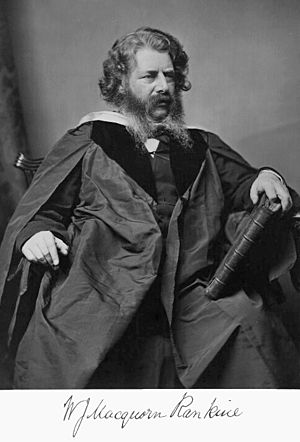Macquorn Rankine facts for kids
Quick facts for kids
William John Macquorn Rankine
|
|
|---|---|

William John Macquorn Rankine
|
|
| Born | 5 July 1820 Edinburgh, Scotland
|
| Died | 24 December 1872 (aged 52) Glasgow, Scotland
|
| Nationality | Scottish |
| Alma mater | University of Edinburgh |
| Known for |
|
| Awards | Keith Medal (1854) |
| Scientific career | |
| Fields | Physics, engineering, civil engineering |
| Institutions | University of Glasgow |
| Influenced | Pierre Duhem |
William John Macquorn Rankine (5 July 1820 – 24 December 1872) was a clever Scottish engineer. He worked in mechanical engineering, but also helped with civil engineering, physics, and mathematics. He was one of the first people to study thermodynamics, which is about how heat and energy work. He especially focused on the first law of thermodynamics.
Rankine also created the Rankine scale. This is a way to measure temperature, much like the Kelvin scale. But instead of using Celsius degrees, it uses Fahrenheit degrees.
He developed a full theory for how steam engines work. This theory covered all kinds of heat engines. His engineering books were used for many years after he published them in the 1850s and 1860s. He wrote hundreds of papers and notes on science and engineering. His interests were very wide. When he was young, he studied botany (plants), music theory, and number theory (math). Later, he studied most major areas of science, math, and engineering.
Rankine was also a big fan of music. He was an amateur singer, played the piano, and the cello. He even wrote his own funny songs!
Contents
Rankine's Contributions to Science
Rankine was a very important person in the world of science and engineering. He helped us understand how heat and energy behave. This field is called thermodynamics.
Understanding Heat and Energy
Rankine worked with other famous scientists like Rudolf Clausius and William Thomson (Lord Kelvin). Together, they helped create the science of thermodynamics. This science explains how heat can be turned into work. It also explains how energy moves around.
One of his main achievements was helping to explain the first law of thermodynamics. This law is about the conservation of energy. It means that energy cannot be created or destroyed. It can only change from one form to another.
The Rankine Temperature Scale
Rankine created his own temperature scale, called the Rankine scale. It is similar to the Kelvin scale. Both scales start at absolute zero, which is the coldest possible temperature. However, the Rankine scale uses degrees Fahrenheit. The Kelvin scale uses degrees Celsius. This made it useful for engineers in countries that used Fahrenheit.
Designing Engines and Structures
Rankine's work on the steam engine was very important. He created a complete theory for how these engines work. This helped engineers design better and more efficient steam engines. These engines powered factories, trains, and ships.
He also wrote many engineering manuals. These books explained science and engineering practices. They were used by students and engineers for many decades. His books helped train many future engineers.
A Man of Many Talents
William Rankine was not just a brilliant scientist and engineer. He had many other interests and hobbies.
Early Life and Diverse Interests
Rankine was born in Edinburgh, Scotland, in 1820. From a young age, he showed a wide range of interests. He studied plants (botany) and even music theory. He also enjoyed number theory, which is a part of mathematics. This shows he was curious about many different subjects.
Music and Creativity
Rankine loved music. He was an amateur musician, meaning he played for fun, not as a job. He enjoyed singing and playing both the piano and the cello. He even wrote his own humorous songs. This shows he had a creative side beyond his scientific work. It also tells us he had a good sense of humor.
Images for kids
See also
 In Spanish: William John Macquorn Rankine para niños
In Spanish: William John Macquorn Rankine para niños


